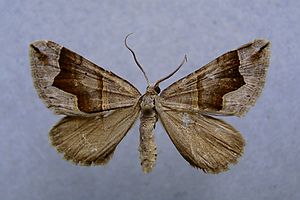Angle binding shaft belt tensioner
| Angle binding shaft belt tensioner | ||||||||||||
|---|---|---|---|---|---|---|---|---|---|---|---|---|

Angular bandage wedge tensioners ( Scotopteryx moeniata ) |
||||||||||||
| Systematics | ||||||||||||
|
||||||||||||
| Scientific name | ||||||||||||
| Scotopteryx moeniata | ||||||||||||
| ( Scopoli , 1763) |
The Winkelbindiger Wellenstriemenspanner ( Scotopteryx moeniata ), also called Winkelbindiger Wellenstriemenspanner , Dark Brown Banded Line Tensioner or Wall Tensioner , is a butterfly ( moth ) from the Spanner family (Geometridae) and is classified in their subfamily Larentiinae .
features
butterfly
The wingspan of the moth is 26 to 34 millimeters. The basic color of the upper side of the forewing varies from light gray to bluish gray to light brown gray. The black-brown to dark red-brown middle field, slightly brightened in the center, is framed by light lines. A strong, single, tooth-like tip pointing towards the edge is striking. The apex is divided by a dark slash. The upper side of the hind wing is almost unmarked gray to gray-brown. The antennae of the males are combed, those of the females are thread-like.
egg
The egg has an oval shape, a glossy orange yellow color and is covered with a reticulate structure. The Mikropylrosette is six to seven leaved.
Caterpillar
Adult caterpillars are gray-brown, sometimes with a slightly reddish shimmer, finely speckled dark brown and provided with short bristles. They have an interrupted dark back as well as two dark longitudinal lines on each side. The stigmas are black, the belly is light.
Doll
The cloudy red-brown colored doll shows light segment incisions and a dark cremaster .
Similar species
Scotopteryx angularia ( Syn .: Scotopteryx diniensis ) has the same drawing elements as Scotopteryx moeniata , but tends to be more light brown to yellow-brown tones in the overall appearance . A genital morphological examination is advisable fora reliable determination.
Distribution and occurrence
The angular tie shaft belt tensioner is widespread locally in Europe, but is absent in some northern regions. There were only a few indications from the British Isles . The southeast or eastern distribution extends to the Caucasus and the Urals . The species prefers calcareous or loess-rich terrain. In the Alps it occurs at altitudes of up to around 1,600 meters. It inhabits gorse heaths, warm slopes, abandoned vineyards, forest edges as well as wastelands and semi-arid lawns.
Way of life
The diurnal and nocturnal moths fly in one generation from mid-July to early September. During the day they were sucking on heather ( Calluna vulgaris observed). They can easily be scared out of the vegetation. At night they come to artificial light sources . The caterpillars live from September, overwinter and pupate in June of the following year. They feed on different plants. These include laburnum - ( Laburnum ), gorse - ( Genista ) and cytisus TYPES ( Cytisus ).
Danger
The angular tie-shaft belt tensioner occurs in different numbers in the German federal states, is considered lost in some northern German regions and is listed as "endangered" on the Red List of Endangered Species .
swell
Individual evidence
- ↑ a b c Walter Forster, Theodor A. Wohlfahrt: The butterflies of Central Europe. Volume 5: Spanner. (Geometridae). Franckh'sche Verlagshandlung, Stuttgart 1981, ISBN 3-440-04951-5 .
- ↑ Jean Bourgogne: Ortholitha diniensis Neub. bona sp. Note sur qucs especes du genre Ortholitha HB. (Lep.Geometridae). Bull. Soc. ent. France, 1941, pp. 86-91
- ^ A b Günter Ebert (Hrsg.): The butterflies of Baden-Württemberg Volume 8, Nachtfalter VI (Spanner (Geometridae) 1st part), Ulmer Verlag Stuttgart 2001. ISBN 3-8001-3497-7
- ↑ UKmoths
- ↑ Federal Agency for Nature Conservation (Ed.): Red List of Endangered Animals in Germany. Landwirtschaftsverlag, Münster 1998, ISBN 3-89624-110-9
literature
- Manfred Koch , Wolfgang Heinicke, Bernd Müller: We determine butterflies. Volume 4: Spanner. 2nd, improved and enlarged edition. Neumann, Leipzig / Radebeul 1976, DNB 780451570 .
- Walter Forster , Theodor A. Wohlfahrt : The butterflies of Central Europe. Volume 5: Spanner. (Geometridae). Franckh'sche Verlagshandlung, Stuttgart 1981, ISBN 3-440-04951-5 .
- Günter Ebert (Ed.): The butterflies of Baden-Württemberg Volume 8, Nachtfalter VI (Spanner (Geometridae) 1st part), Ulmer Verlag Stuttgart 2001. ISBN 3-8001-3497-7
Web links
- Lepiforum eV - taxonomy and photos
- www.euroleps.ch - photos
- Butterflies-Deutschlands.de - endangerment
- www.lepidoptera.eu - Occurrence in Europe
- Scotopteryx moeniata in Fauna Europaea. Retrieved July 5, 2015